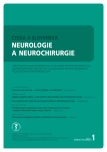A randomized controlled study of the effect of balance disorder therapy using audiovisual feedback on senior citizens
Authors:
L. Šajtárová 1; M. Janatová 2,3; T. Veselý 2,3; M. Lopotová 1,2; P. Smrčka 2,3; K. Hána 2,3
Authors‘ workplace:
Therap – Tilia s. r. o.
1; Fakulta biomedicínského inženýrství, ČVUT v Praze
2; Centrum podpory aplikačních výstupů a spin-off firem, 1. LF UK, Praha
3
Published in:
Cesk Slov Neurol N 2020; 83(1): 101-104
Category:
doi:
https://doi.org/10.14735/amcsnn2020101
Overview
Aim: The purpose of the study was to investigate the effect of therapy based on the use of a force platform and audiovisual feedback on the balance of senior citizens and to compare it to the effect of conventional therapy in control group.
Patients and methods: A research group of 15 senior citizens (12 women) underwent 9 therapeutic units with an audiovisual feedback. A control group of 15 senior citizens (14 women) completed 9 therapeutic units of conventional physiotherapy. Both groups underwent an initial examination, the same number of therapeutic units and a final examination. The Mini-BESTest, Timed Up and Go test and the time limit needed to complete the reference scene in the Homebalance system were chosen to evaluate the effect of the therapy.
Results: There was a statistically significant improvement in the Mini-BESTest (P = 0.05), Timed Up and Go test (P = 0.01) and in the reference scene completion time (median 68 s) in the research group. The control group had only a statistically significant improvement in the reference scene completion time (median 11 s). The improvement in reference scene completion time was statistically significantly higher in the research group than in the control group (P = 0.01).
Conclusion: Audiovisual feedback is a safe and useful tool in the treatment of balance disorders in senior citizens. The therapy with force platform and audiovisual feedback was more effective than conventional physiotherapy which does not employ technical aids.
Keywords:
senior – posture stability – force platform – audiovisual feedback
Sources
1. Krobot A, Kolářová B, Kolář P et al. Neurorehabilitace chůze po cévní mozkové příhodě. Cesk Slov Neurol N 2017; 80/ 113(5): 521–526. doi: 10.14735/ amcsnn2017521.
2. Tripette J, Murakami H, Ryan KR et al. The contribution of Nintendo Wii Fit series in the field of health: a systematic review and meta-analysis. PeerJ 2017; 5: e3600. doi: 10.7717/ peerj.3600.
3. Clark RA, Mentiplay BF, Pua YH et al. Reliability and validity of the Wii Balance Board for assessment of standing balance: a systematic review. Gait Posture 2018; 61: 40–54. doi: 10.1016/ j.gaitpost.2017.12.022.
4. Janatová M, Tichá M, Melecký R et al. Pilotní studie využití tenzometrické plošiny v domácí terapii poruch rovnováhy. Cesk Slov Neurol N 2016; 79/ 112(5): 591–594.
5. Choi SD, Guo L, Kang D et al. Exergame technology and interactive interventions for elderly fall prevention: a systematic literature review. Appl Ergon 2017; 65: 570–581. doi: 10.1016/ j.apergo.2016.10.013.
6. Chao Y, Scherer YK, Montgomery CA. Effects of using Nintendo Wii™ exergames in older adults: a review of the literature. J Aging Health 2015; 27(3): 379–402. doi: 10.1177/ 0898264314551171.
7. Amorim JS, Leite RC, Brizola R. et al. Virtual reality therapy for rehabilitation of balance in the elderly: a systematic review and META-analysis. Adv Rheumatol 2018; 58(1): 18. doi: 10.1186/ s42358-018-0013-0.
8. Donath L, Rössler R, Faude O. Effects of virtual reality training (exergaming) compared to alternative exercise training and passive control on standing balance and functional mobility in healthy community-dwelling seniors: a meta-analytical review. Sports Med 2016; 46(9): 1293–1309. doi: 10.1007/ s40279-016-0485-1.
Labels
Paediatric neurology Neurosurgery NeurologyArticle was published in
Czech and Slovak Neurology and Neurosurgery

2020 Issue 1
Most read in this issue
- Neonatal seizures – current view of the issue
- Possible prevention of Alzheimer’s disease
- The primary Non-Hodgkin’s central nervous system lymphoma
- Neuropsychiatric symptoms as early manifestation of Alzheimer’s disease
